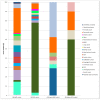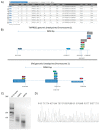RNA-Based Detection of Gene Fusions in Formalin-Fixed and Paraffin-Embedded Solid Cancer Samples
- PMID: 31491926
- PMCID: PMC6769558
- DOI: 10.3390/cancers11091309
RNA-Based Detection of Gene Fusions in Formalin-Fixed and Paraffin-Embedded Solid Cancer Samples
Abstract
Oncogenic gene fusions are important drivers in many cancer types, including carcinomas, with diagnostic and therapeutic implications. Hence, sensitive and rapid methods for parallel profiling in formalin-fixed and paraffin-embedded (FFPE) specimens are needed. In this study we analyzed gene fusions in a cohort of 517 cases where standard treatment options were exhausted. To this end the Archer® DX Solid tumor panel (AMP; 285 cases) and the Oncomine Comprehensive Assay v3 (OCA; 232 cases) were employed. Findings were validated by Sanger sequencing, fluorescence in situ hybridization (FISH) or immunohistochemistry. Both assays demonstrated minimal dropout rates (AMP: 2.4%; n = 7/292, OCA: 2.1%; n = 5/237) with turnaround times of 6-9 working days (median, OCA and AMP, respectively). Hands-on-time for library preparation was 6 h (AMP) and 2 h (OCA). We detected n = 40 fusion-positive cases (7.7%) with TMPRSS2::ERG in prostate cancer being most prevalent (n = 9/40; 22.5%), followed by other gene fusions identified in cancers of unknown primary (n = 6/40; 15.0%), adenoid cystic carcinoma (n = 7/40; 17.5%), and pancreatic cancer (n = 7/40; 17.5%). Our results demonstrate that targeted RNA-sequencing of FFPE samples is feasible, and a well-suited approach for the detection of gene fusions in a routine clinical setting.
Keywords: NGS; carcinoma; gene fusion; solid tumor; targeted therapy.
Conflict of interest statement
Albrecht Stenzinger: Advisory board honoraria from Bayer, Novartis, BMS, AstraZeneca, ThermoFisher, Illumina; speaker´s honoraria from Takeda, Roche, BMS, Illumina, AstraZeneca, Novartis, ThermoFisher, Bayer, MSD and research funding from Chugai and BMS. Volker Endris: Advisory board honoraria from ThermoFisher; Speaker´s honoraria from AstraZeneca. Peter Schirmacher: Advisory board honoraria from Pfizer, Roche, Novartis and AstraZeneca; speaker´s honoraria and research funding from Roche, AstraZeneca and Novartis. Anna-Lena Volckmar: Funding from AstraZeneca for a talk. Alwin Krämer: Reimbursement of study-related traveling and molecular tumor board work by Roche. Tilman Bochtler: Reimbursement of study-related traveling and molecular tumor board work by Roche. The sponsors had no role in the design, execution, interpretation, or writing of the study. M.K., O.N., M.A., J.B., E.R., R.P., R.B., D.K., S.B.T., L.J., F.S., M.v.W. and C.S. declare no conflict of interest.
Figures





References
-
- Taub R., Kirsch I., Morton C., Lenoir G., Swan D., Tronick S., Aaronson S., Leder P. Translocation of the c-myc gene into the immunoglobulin heavy chain locus in human Burkitt lymphoma and murine plasmacytoma cells. Proc. Natl. Acad. Sci. USA. 1982;79:7837–7841. doi: 10.1073/pnas.79.24.7837. - DOI - PMC - PubMed
-
- Melo J.V. The molecular biology of chronic myeloid leukaemia. Leukemia. 1996;10:751–756. - PubMed
-
- Koelsche C., Hartmann W., Schrimpf D., Stichel D., Jabar S., Ranft A., Reuss D.E., Sahm F., Jones D.T.W., Bewerunge-Hudler M., et al. Array-based DNA-methylation profiling in sarcomas with small blue round cell histology provides valuable diagnostic information. Mod. Pathol. 2018;31:1246–1256. doi: 10.1038/s41379-018-0045-3. - DOI - PMC - PubMed
LinkOut - more resources
Full Text Sources

